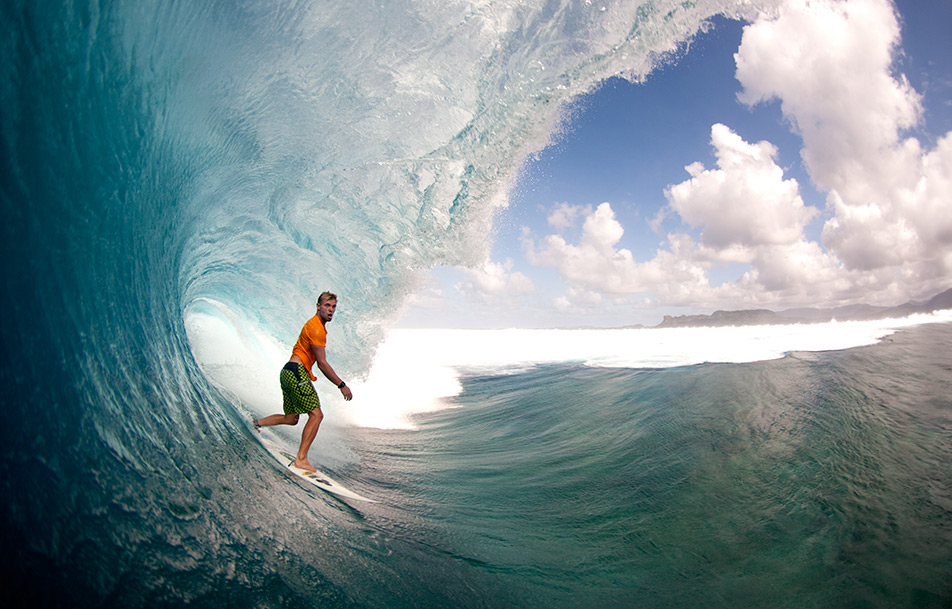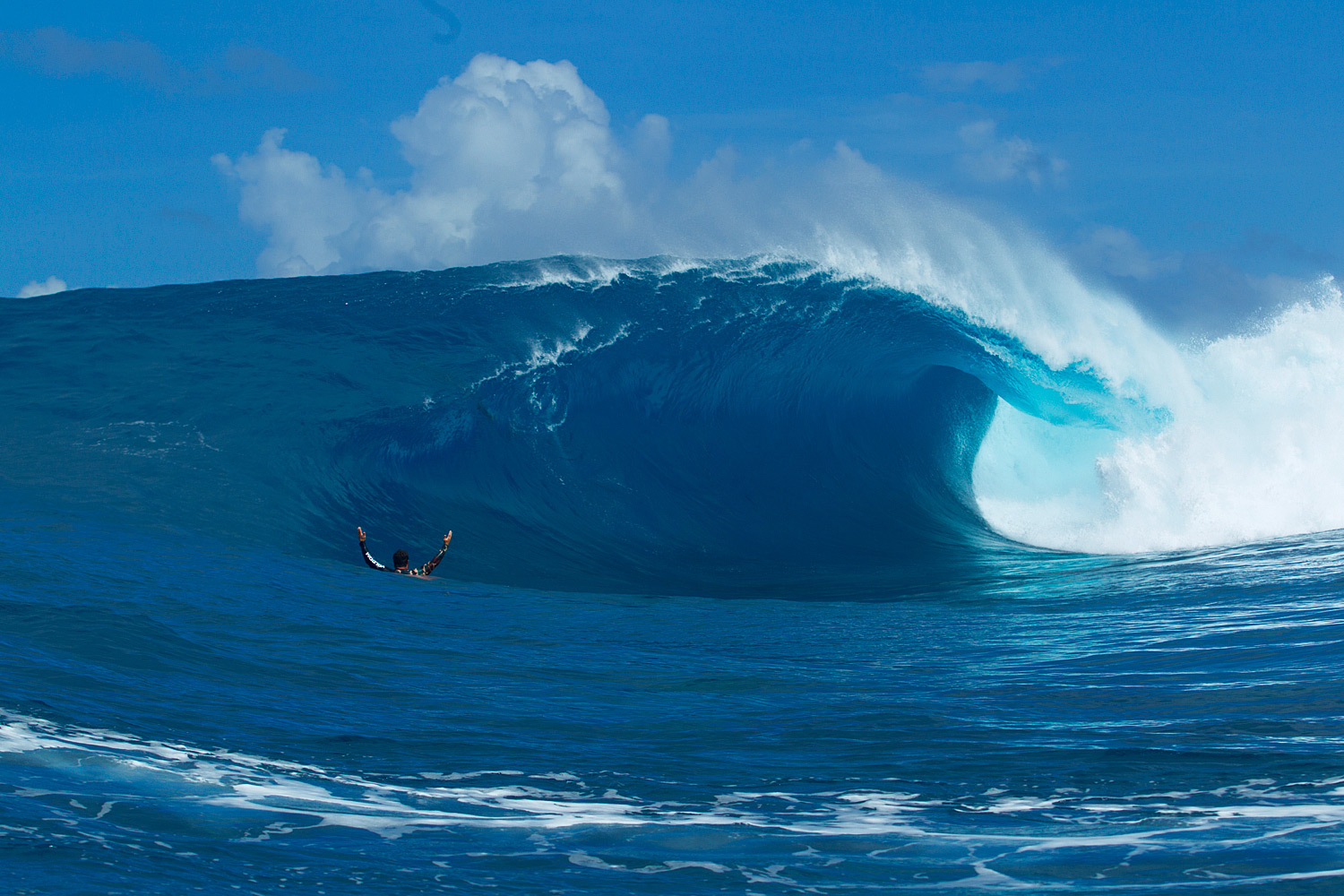P-Pass / Micronesia – Surf – Pohnpei – Micronesia

 Surfergalaxy
Surfergalaxy 
| Wave | Right |
| Ola | Derecha |
| Wind | E - SE |
| Tide | Medium - High |
| Marea | Media - Alta |
| Swell | NW |
| Bottom | Coral reef |
| Fondo | Arrecife de coral |
| Time of year | From November to April |
| Época del año | De Noviembre a Abril |
P-Pass is an incredibly powerful and consistent wave which, unlike some, has the capacity to adapt. This is because the reef has a perfect form and lets the lines form perfectly above it. In general the wave functions from 4 to 12 feet, with all tides, but better with mid. The season runs from November to April with large swell more likely in December and January.
It is located in the central west of the Pacific Ocean and P-Pass needs a swell that comes from low pressure in the north of Japan. It normally works with 4 ft and depending on the tidal conditions, the dynamic period will be with intermediate periods. With mid to high tide it’s quite long, predictable, fun and very rideable, however, with more than 5 feet and periods of over 16 seconds the situation is quite different and it becomes a very fast wave, a barreling cannon from beginning to end. If it rises above 8 ft it’s a high level wave which is still amazing as its dynamic is the same as with 5 ft. In any case if you’re a good surfer it’s a magical and predictable wave that helps you control the speed both to enter the pipe and to link turns. You’ll find there is a friendly atmosphere around this wave and your smile and collaboration is very important so that in the future this wonderful place does not turn into the craze of similar places.
P-Pass es una derecha con un potencial increíble, es muy consistente y posee una capacidad de adaptación como pocas, esto es debido a que el arrecife es perfecto en toda su formación y deja que las líneas se coloquen perfectas sobre él. En líneas generales, P-pass funciona de 4 a 12 pies, con cualquier marea, mejor con media. La temporada va desde noviembre hasta abril y los grandes swell son más probables en diciembre o enero.
Al ubicarse en el Centro-Oeste del Océano Pacífico, P-Pass necesita un swell que proceda de algún frente al norte de Japón. Funciona normalmente con 4 pies y según las condiciones de marea y periodo la dinámica será tal que con periodos intermedios y sobretodo con marea media- alta la ola es bastante larga, previsible y muy surfeable, sin embargo con más de 5 pies y periodos de más de 16 segundos la situación es bastante distinta y se convierte en una ola muy rápida con tubo de principio a fin, si sube por encima de 8 pies es exclusiva para riders de alto nivel, sin embargo, es tan buena que es increíble como su dinámica es igual que con 5 pies. En cualquier caso si eres un buen surfer es una fantástica ola, previsible y que te facilita el control de la velocidad, tanto para entrar en el tubo como para enlazar giros. Es una ola en la que te encontrarás en un ambiente muy familiar, pero como en cualquier viaje será muy importante tu sonrisa y buena actitud.

The right-hander P-Pass is located in the central west of the Pacific Ocean on Pohnpei Island, which is also known as the Emerald of the Pacific because of its beauty. It belongs to the Federated States of Micronesia, formerly known as the Caroline Islands. Like other islands located in the middle of the ocean such as Fiji, Tahiti and Hawaii, the waves have extra power so you shouldn’t underestimate P-Pass as the edge of the reef is more than ten metres deep and this means the swell doesn’t lose any energy upon arrival.
This wave was discovered relatively recently, at the beginning of the nineties, and is considered as one of the ten best right-handers in the world. To get to it you have to go towards the channel known as Palikir Pass, which is where P-Pass breaks and also where its name comes from. Only United Airlines fly to Pohnpei and the flights arrive at Kolonia International Airport which isn’t far from P-Pass. It won’t be difficult to find accommodation there, but keep in mind that the cost difference between one place and another is the proximity to P-Pass as if you stay around Palikir you»ll be a 40 mintue boat ride away whereas if you opt to stay in one of the nearby surf camps you’ll only be 10 minutes away.
Not long ago it was unknown and now it’s one of the most sought after. With the diffusion of some epic sessions showing some well-known surfers demonstrating its potential, it’s likely that P-Pass will soon give us a lot to talk about. There are two important reasons for going there. One is that P-Pass is a wave that when it’s half its size, it gives opportunities for intermediate level surfers and the other is that Pohnpei doesn’t get crowded, even in high season, and if that’s not enough, there are other good quality waves nearby. You can be sure that you’ll have an original surf trip in Pohnpei as it’s easy to lose track of time there but it still maintains the essence that the Micronesian villagers transmit. The Australian magazine Tracks, said «Just when you thought you had surferd the best waves in the world, there is always a diamond in the rough».
La derecha de P-Pass se encuentra en el Centro-Oeste del Océano Pacifico, en la Isla de Pohnpei, isla que por su belleza es conocida como la esmeralda del Pacifico. Pertenece a los Estados Federados de Micronesia, antes conocidos como Islas Carolinas. Ponhpei se encuentra en mitad del océano y como pasa en otras islas similares las olas tienen una potencia extra, que en P-Pass se ve acrecentada debido a que en el borde del arrecife hay una profundidad de más de quince metros en vertical y por ello las series no pierden energía a su llegada.
Esta derecha se descubrió a principios de los noventa y a pesar de su reciente historia es ya considerada una de las diez mejores derechas del mundo. Para llegar a ella hay que dirigirse al canal conocido como Palikir Pass, lugar de donde deriva su nombre P-Pass. En Pohnpei la única compañía aérea es United Airlines, sus vuelos llegan al aeropuerto internacional de Kolonia, no muy lejos de P-Pass. No es difícil encontrar alojamiento, las diferencias de precio entre unos lugares las determina la cercanía a P-Pass, si te quedas alrededor de Palikir estarás a 40 minutos en bote, en cambio, sí optas por alguno de los Surf-camp más cercanos a la ola estarás a 10 minutos.
Hasta hace poco era una desconocida y ahora es una de las más deseadas. La difusión reciente de algunas sesiones épicas en las que aparecen algunos reconocidos surfers muestra su potencial y seguro que en un futuro cercano P-Pass va a dar mucho que hablar. Hay dos razones muy importantes para venir aquí, una es que P-Pass es una ola que con tamaño medio da oportunidades a aquellos surfers de nivel intermedio, la otra es que en Pohnpei incluso en plena temporada no hay grandes masificaciones, y además hay olas de mucha calidad muy cercanas entre sí. Seguro en Pohnpei realizarás un original surftrip, es este un lugar donde se pierde la noción del tiempo y que mantiene la original esencia transmitida por sus primeros pobladores micronesios. La Tracks australiana dijo en una de sus páginas «Just when you thought you had surferd the best waves in the world, there is always a diamond in the rough».
Pohnpei is an archipelago formed by islands that are in reality volcanic mountains submerged in the middle of the Pacific Ocean. This location and nature makes it incredibly beautiful and fertile with abundant water and vegetation. It’s surprising that this island doesn’t have any beaches, its people say that the legend of the Gods created such a beautiful place and they decided not to have any beaches as they knew that man would destroy the original beauty of them in the future. It’s recommended to hire a car as it takes about three hours to make a trip around the whole island, enjoying the unique spectacular nature. In the main cities, you’ll find operators that can help with diving, hiking trips, trips to see the Sahwartik and Kaprohei waterfalls or take you to the strategic points to see the schools of barracudas and maybe the occasional shark.
But if there is something important and interesting that you cannot miss it’s the aquatic city of Nan Madol, the ancient Venice of the Pacific, where you’ll see the ruins of this enigmatic city that was founded at the beginning of our era. Another exciting tour is to go to the Sokehs mountains, where the former Japanese military had an observation post in World War II. You’ll see it among the lush vegetation along with rusty old tanks sticking out and other war artifacts from that era.
Pohnpei es un archipiélago formado por unas islas que en realidad son montañas volcánicas sumergidas en medio del Océano Pacifico, esta localización y naturaleza hace que sean increíblemente bonitas, fértiles, con abundante agua y vegetación. Es sorprendente que en esta isla no se encuentran playas, dice la leyenda que los Dioses en su creación hicieron de Pohnpei un lugar tan bello, que cuando terminaron no quisieron que tuviera playas porque sabían que con ellas en el futuro se destruiría esa original belleza. Es una opción muy recomendable alquilar un vehículo, tardarás aproximadamente tres horas en coche en darle la vuelta a la isla disfrutando de un espectáculo natural único. En las ciudades principales encontrarás operadores que te facilitarán poder ir a bucear, hacer senderismo, ver las cascadas de Sahwartik y Kaprohei o llevarte a estratégicos puntos para ver bancos de Barracudas y con suerte algún ocasional tiburón.
Algo importante que no puedes dejar de ver es la ciudad acuática de Nan Madol, la antigüa Venecia del pacifico, allí verás las antiguas ruinas de esta enigmática ciudad fundada a principio de nuestra era. Otra buena excursión es ir hacia las montañas de Sokehs, antigüa base militar japonesa en la segunda guerra mundial, podrás ver entre la frondosa vegetación como asoman oxidados carros de combate, tanques y demás artilugios bélicos de esa época.